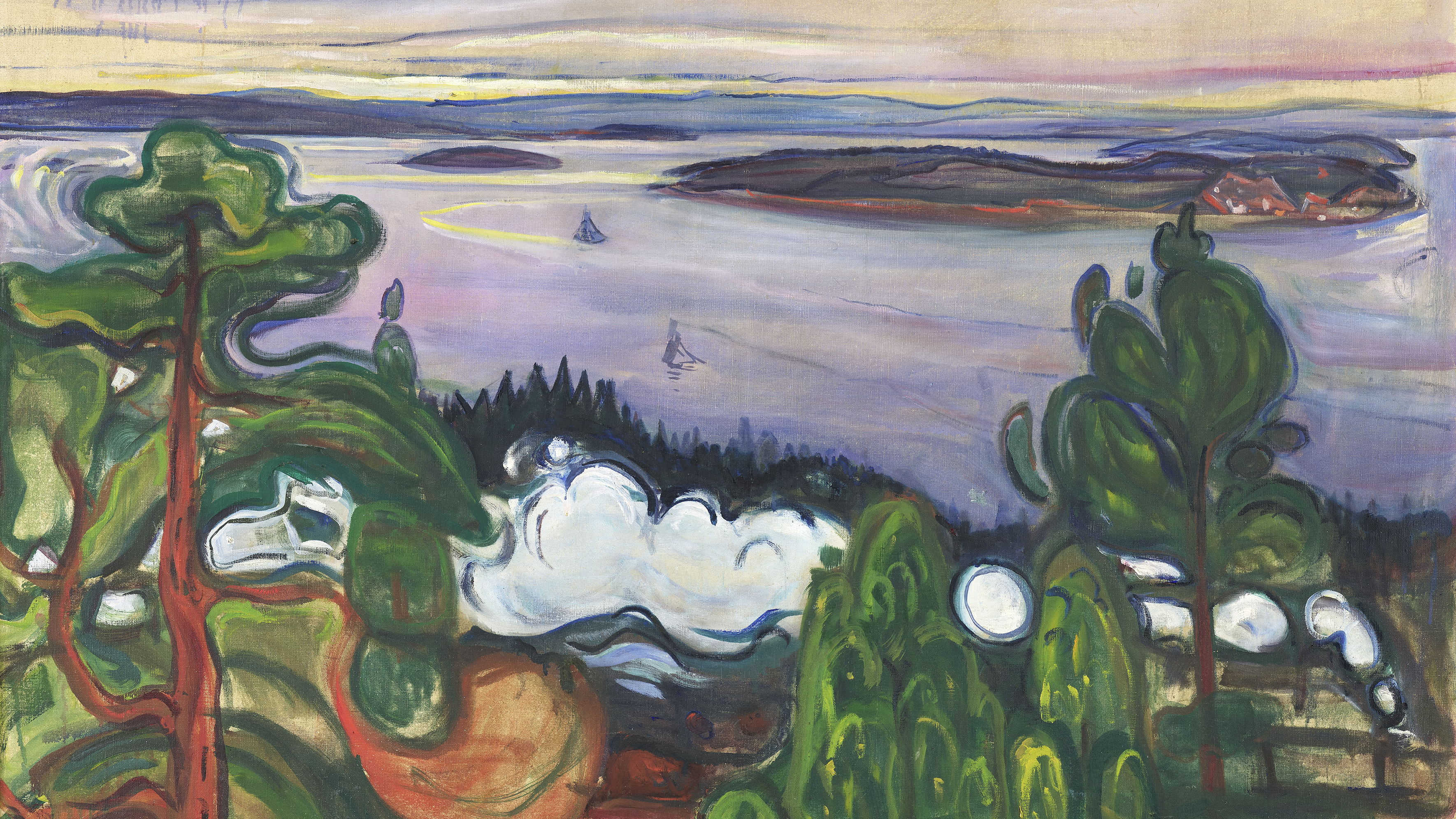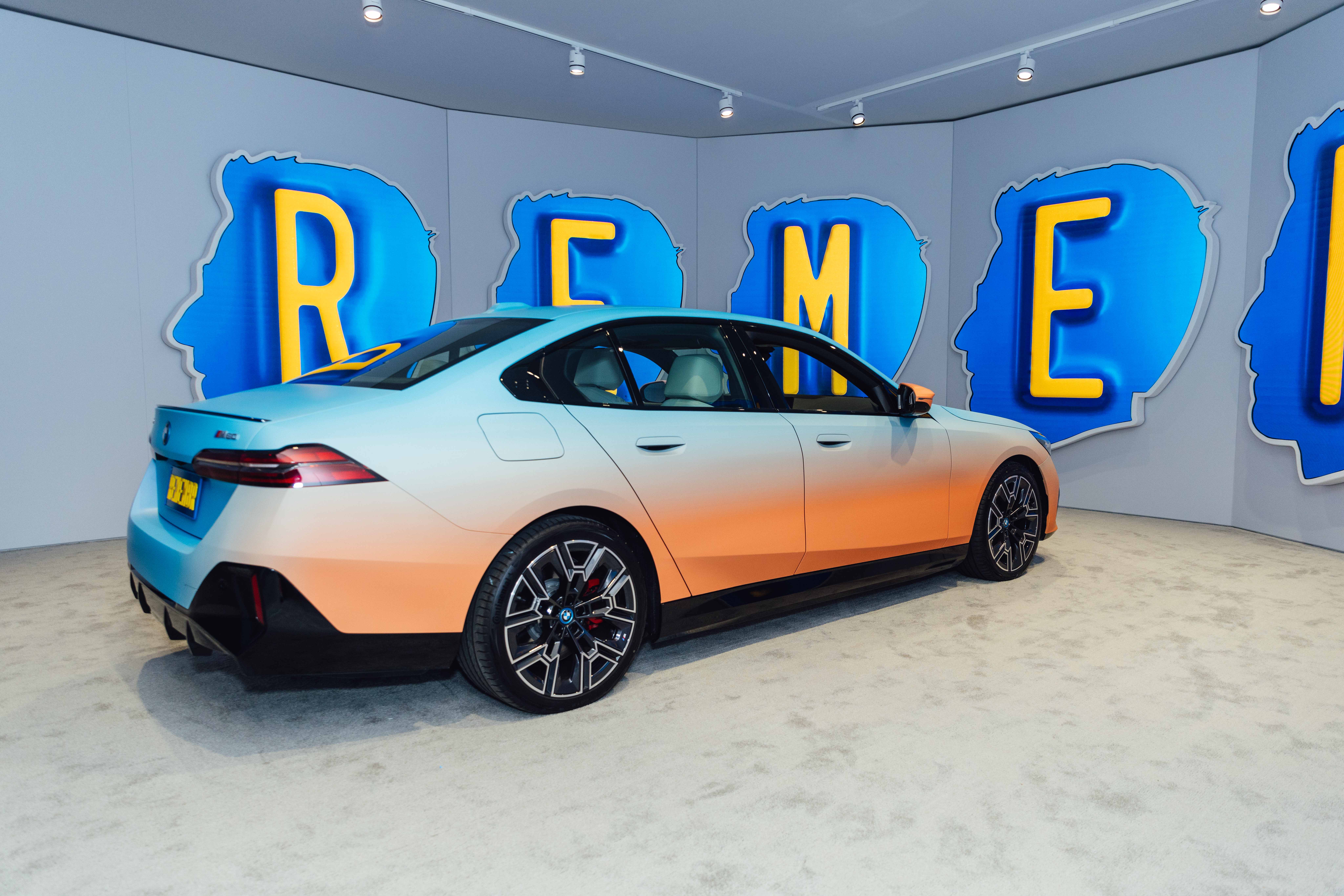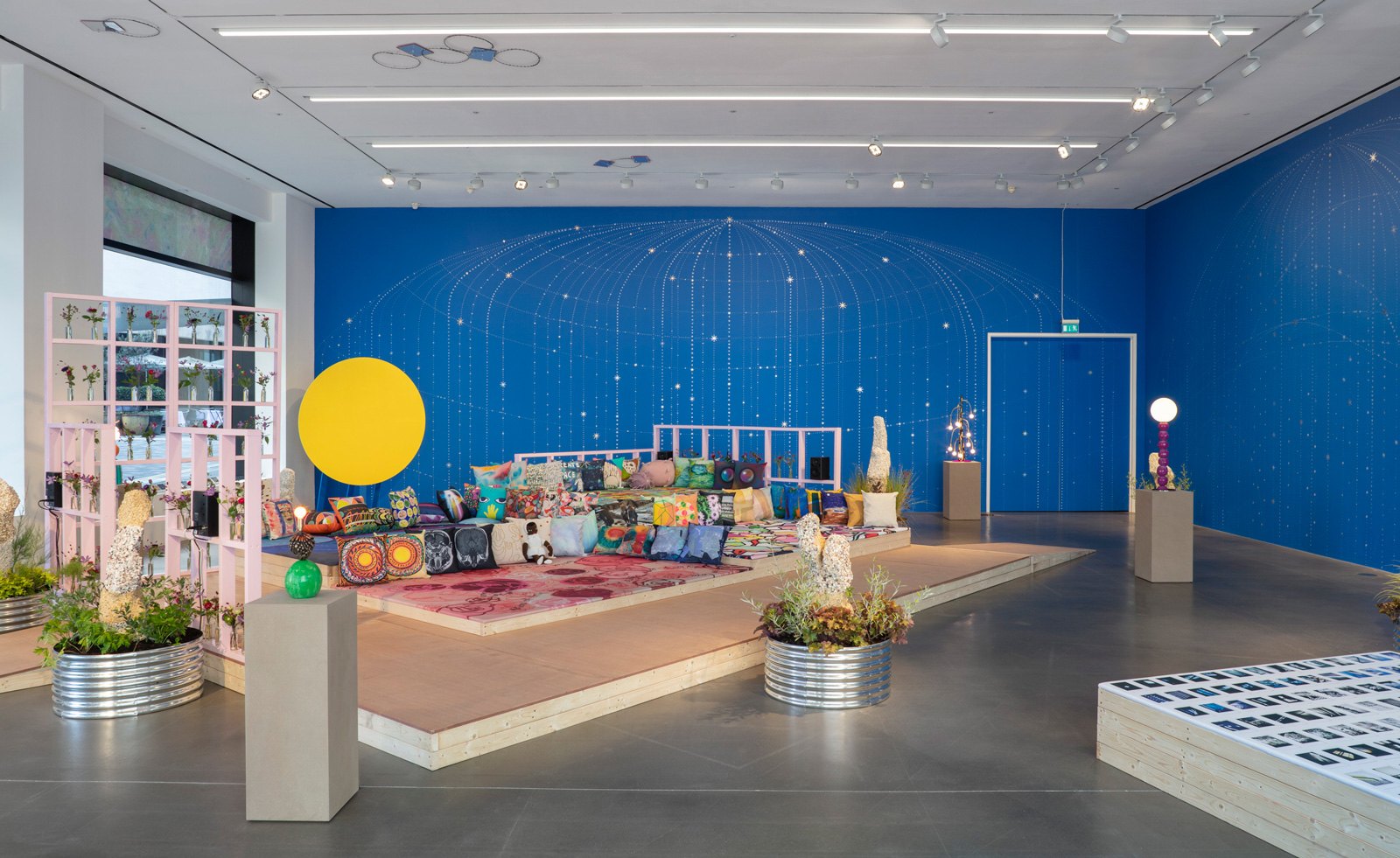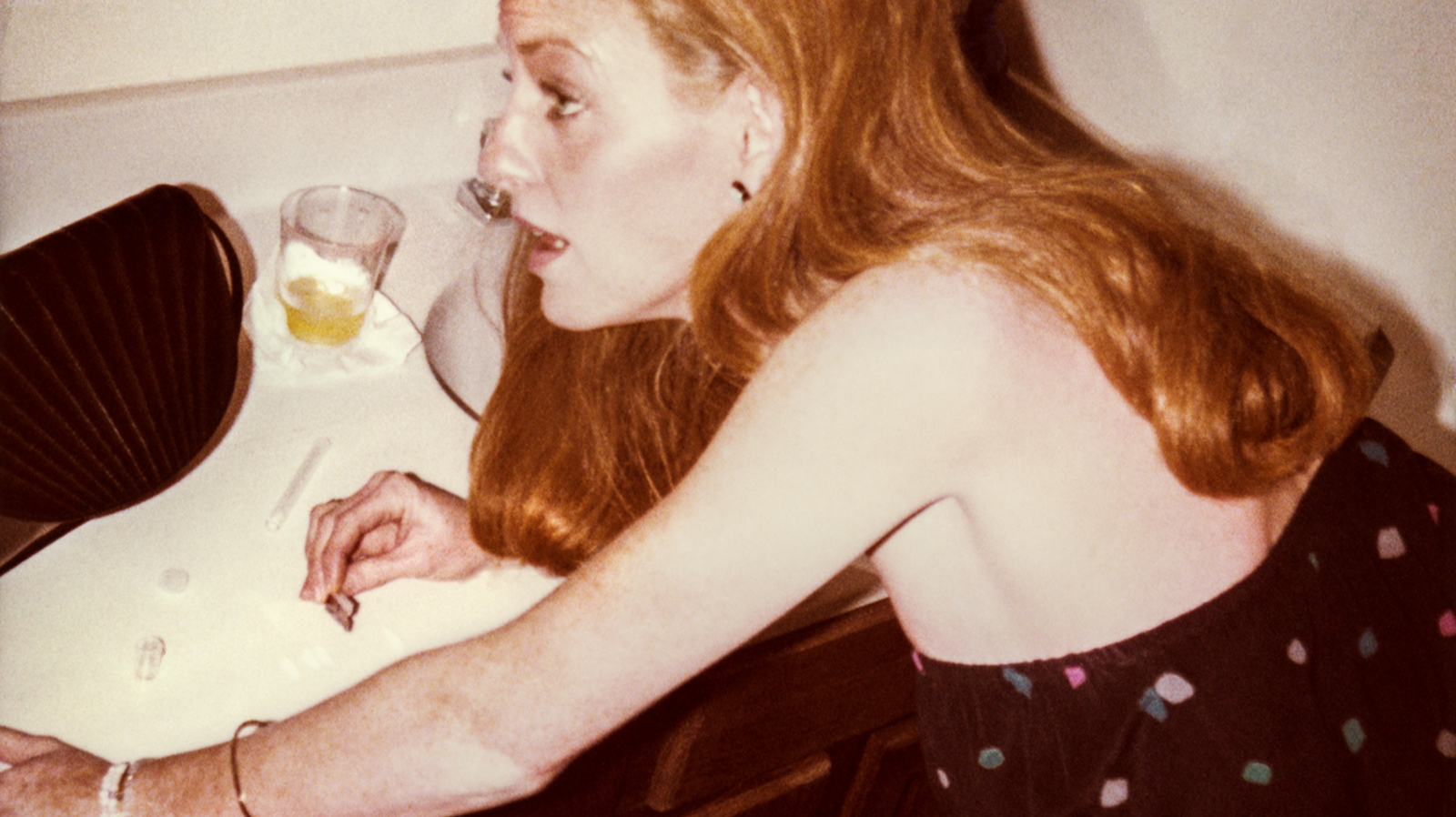
If you find yourself in Marseille on a cloudy summer night, gaze up to the sky and you just might see the Bat Signal. Projected from the rooftop of Le Corbusier’s Cité Radieuse, it pierces through the dark night and casts a familiar emblem in white light, as though the city were summoning Gotham’s favourite superhero. This is the audacious headliner for Californian artist Alex Israel’s Batman-themed exhibition at Marseille Modulor (MAMO), the contemporary art centre founded in 2013 by designer Ora ïto.
Israel is the seventh artist to take over MAMO for the summer, following on an older, and largely Francophone roster that has included Xavier Veilhan, Daniel Buren, Dan Graham and Felice Varini. He often engages with the seductive power of Hollywood, reframing movie props as readymade sculptures that capture a cultural moment, and at MAMO, Israel’s choice of subject responds in part to the architecture.
Occupying the top levels of the Cité Radieuse, the art centre comprises a double-height gymnasium with a striking curved ceiling, and a roof terrace anchored by an undulating chimney. The elegant bulk of the concrete building, combined with sweeping views of the city’s terracotta rooftops and the azure Mediterranean, make it the perfect superhero’s lair. But the artist was also inspired by Marseille’s historic reputation for violence and crime, explaining, ‘It’s the idea of this really tough and gritty city which made me think of Gotham.’

Bat-Signal 1989, 2019, by Alex Israel. Courtesy of MAMO, Marseille Modulor
Israel fixated on the 1989 Batman film (directed by Tim Burton, and with production design by Anton Furst), which he’d first seen as a six-year-old. ‘It deeply and profoundly impacted me like those kinds of experiences do when you’re young,’ he recalls. The artist particularly liked that Batman doesn’t have any superpowers. ‘He just has to do the best he can as a human.’
As far as solo exhibitions go, this one is succinct. A Batmobile has materialised in the centre of the gymnasium, which has been darkened to emulate the iconic Batcave. Grumbling engines, billowing smoke heighten the sense of drama, and give the impression that the car is about to speed off. Within the dim space, the aquiline form and scalloped tailfins of the Batmobile seem to take on a new aura. ‘In the dark, it loses its objectness and becomes this reflective surface for light, and kind of a breathing thing,’ he muses. ‘It’s almost like a memory or a fantasy.’ Israel is interested in how the installation will inform the viewer’s perception of a car that he calls ‘the ultimate fetish’.
Meanwhile, on one corner of the roof terrace sits the Bat Signal, housed in a modified Second World War era searchlight – the same make as the one that appears towards the end of the movie. By day, its white exterior contrasts with a mirrored reflector punctuated, of course, by the Batman logo. After sundown it lights up, its conical beam in delightful dialogue with the form of Le Corbusier’s chimney. Weather permitting, Batman’s emblem will glow amongst the clouds – a world first, considering that the movies had relied on special effects. ‘It seemed perfect in this specific place above a city with a history that aligns with the meaning of Batman,’ explains Israel. ‘This is a symbol of hope, heroism and courage, of Hollywood and America.’
Ora ïto had planted the idea of this piece two months ago when, in a last-ditch effort to convince Israel to take on the show, he’d told the artist, ‘You can do whatever you want. You can even put the Bat Signal all over Marseille.’ At the opening last week, the French designer seemed delighted, and perhaps still in disbelief that his casual remark has now become reality. ‘What’s genius about the show, I think, is that the old building becomes the art piece. For me, Alex is the new Andy Warhol.’
INFORMATION
‘Alex Israel’, 8 June – 31 August, MAMO. mamo.fr
ADDRESS
Centre d’art de la Cité Radieuse
280 Boulevard Michelet
13008 Marseille
Receive our daily digest of inspiration, escapism and design stories from around the world direct to your inbox.
TF Chan is a former editor of Wallpaper* (2020-23), where he was responsible for the monthly print magazine, planning, commissioning, editing and writing long-lead content across all pillars. He also played a leading role in multi-channel editorial franchises, such as Wallpaper’s annual Design Awards, Guest Editor takeovers and Next Generation series. He aims to create world-class, visually-driven content while championing diversity, international representation and social impact. TF joined Wallpaper* as an intern in January 2013, and served as its commissioning editor from 2017-20, winning a 30 under 30 New Talent Award from the Professional Publishers’ Association. Born and raised in Hong Kong, he holds an undergraduate degree in history from Princeton University.
-
 Winston Branch searches for colour and light in large-scale artworks in London
Winston Branch searches for colour and light in large-scale artworks in LondonWinston Branch returns to his roots in 'Out of the Calabash' at Goodman Gallery, London ,
-
 The most anticipated hotel openings of 2026
The most anticipated hotel openings of 2026From landmark restorations to remote retreats, these are the hotel debuts shaping the year ahead
-
 Is the future of beauty skincare you can wear? Sylva’s Tallulah Harlech thinks so
Is the future of beauty skincare you can wear? Sylva’s Tallulah Harlech thinks soThe stylist’s label, Sylva, comprises a tightly edited collection of pieces designed to complement the skin’s microbiome, made possible by rigorous technical innovation – something she thinks will be the future of both fashion and beauty
-
 Switzerland’s best art exhibitions to see in 2025
Switzerland’s best art exhibitions to see in 2025Art fans, here’s your bucket list of the standout exhibitions to see in Switzerland in 2025, exploring compelling themes and diverse media
-
 Alex Israel uses BMW technology for AI-powered video installation at Art Basel Miami Beach 2023
Alex Israel uses BMW technology for AI-powered video installation at Art Basel Miami Beach 2023Alex Israel’s 'REMEMBR' at Art Basel Miami Beach 2023 uses AI technology to curate and choreograph a visitor’s phone camera content into a video installation across seven screens
-
 Edinburgh Art Festival 2023: from bog dancing to binge drinking
Edinburgh Art Festival 2023: from bog dancing to binge drinkingWhat to see at Edinburgh Art Festival 2023, championing women and queer artists, whether exploring Scottish bogland on film or casting hedonism in ceramic
-
 Last chance to see: Devon Turnbull’s ‘HiFi Listening Room Dream No. 1’ at Lisson Gallery, London
Last chance to see: Devon Turnbull’s ‘HiFi Listening Room Dream No. 1’ at Lisson Gallery, LondonDevon Turnbull/OJAS’ handmade sound system matches minimalist aesthetics with a profound audiophonic experience – he tells us more
-
 Hospital Rooms and Hauser & Wirth unite for a sensorial London exhibition and auction
Hospital Rooms and Hauser & Wirth unite for a sensorial London exhibition and auctionHospital Rooms and Hauser & Wirth are working together to raise money for arts and mental health charities
-
 ‘These Americans’: Will Vogt documents the USA’s rich at play
‘These Americans’: Will Vogt documents the USA’s rich at playWill Vogt’s photo book ‘These Americans’ is a deep dive into a world of privilege and excess, spanning 1969 to 1996
-
 Brian Eno extends his ambient realms with these environment-altering sculptures
Brian Eno extends his ambient realms with these environment-altering sculpturesBrian Eno exhibits his new light box sculptures in London, alongside a unique speaker and iconic works by the late American light artist Dan Flavin
-
![The Bagri Foundation Commission: Asim Waqif, वेणु [Venu], 2023. Courtesy of the artist. Photo © Jo Underhill. exterior](https://cdn.mos.cms.futurecdn.net/QgFpUHisSVxoTW6BbkC6nS.jpg) Asim Waqif creates dense bamboo display at the Hayward in London
Asim Waqif creates dense bamboo display at the Hayward in LondonThe Bagri Foundation Commission, Asim Waqif’s वेणु [Venu], opens at the Hayward Gallery in London